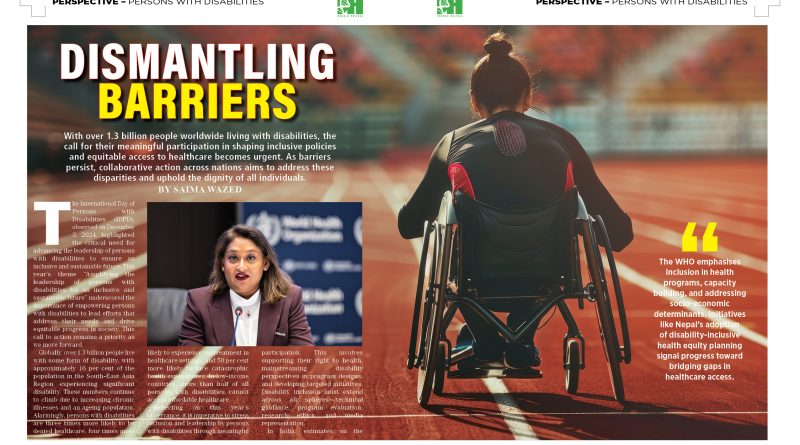Dismantling Barriers
With over 1.3 billion people worldwide living with disabilities, the call for their meaningful participation in shaping inclusive policies and equitable access to healthcare becomes urgent. As barriers persist, collaborative action across nations aims to address these disparities and uphold the dignity of all individuals.
By Saima Wazed
The International Day of Persons with Disabilities (IDPD), observed on December 3, 2024, highlighted the critical need for advancing the leadership of persons with disabilities to ensure an inclusive and sustainable future. This year’s theme “Amplifying the leadership of persons with disabilities for an inclusive and sustainable future” underscored the importance of empowering persons with disabilities to lead efforts that address their needs and drive equitable progress in society. This call to action remains a priority as we move forward.
Globally, over 1.3 billion people live with some form of disability, with approximately 16 per cent of the population in the South-East Asia Region experiencing significant disability. These numbers continue to climb due to increasing chronic illnesses and an ageing population. Alarmingly, persons with disabilities are three times more likely to be denied healthcare, four times more likely to experience mistreatment in healthcare settings, and 50 per cent more likely to face catastrophic health expenditures. In low-income countries, more than half of all persons with disabilities cannot access affordable healthcare.
Reflecting on this year’s observance, it is imperative to stress inclusion and leadership by persons with disabilities through meaningful participation. This involves supporting their right to health, mainstreaming disability perspectives in program designs, and developing targeted initiatives. Disability inclusion must extend across all spheres—technical guidance, program evaluation, research ethics, and media representation.
In India, estimates on the prevalence of disability vary. The World Bank estimates that 4–8 per cent of the country’s population, or roughly 40–90 million individuals, live with disabilities. Meanwhile, the 2011 Census reported 2.68 crore persons with disabilities, constituting 2.21 per cent of the total population. India, as a party to the United Nations Convention on the Rights of Persons with Disabilities (UNCRPD), has made strides in addressing these issues.
National institutes play a pivotal role in supporting persons with disabilities in India. These include:
National Institute for the Empowerment of Persons with Visual Disabilities (NIEPVD) in Dehradun.
Ali Yavar Jung National Institute of Speech and Hearing Disabilities (AYJNISHD) in Mumbai.
National Institute for the Empowerment of Persons with Intellectual Disabilities (NIEPID) in Secunderabad.
National Institute for Empowerment of Persons with Multiple Disabilities (NIEPMD) in Chennai.
The United Nations Disability Inclusion Strategy (UNDIS) mandates that all UN entities actively consult with organisations of persons with disabilities (OPDs), not just on disability-specific matters but across all issues. WHO’s reasonable accommodation policy supports inclusion for staff, consultants, and dependents with disabilities, ensuring accessibility in all organisational engagements.
In the WHO South-East Asia Region, several initiatives reflect this commitment. The SEARO CARE initiative prioritises the health and wellbeing of staff and family members with disabilities. This effort aims to create a supportive environment where everyone feels valued. The Regional ROADMAP, focused on equity and inclusion, provides a framework for incorporating disability perspectives into healthcare strategies. Moreover, future efforts will emphasise disability inclusion, mental health, and psychosocial support, especially in emergency settings.
Barriers to advancing disability inclusion often stem from limited understanding and narrow perceptions of the health needs of persons with disabilities. Addressing these barriers involves expanding awareness of inclusion, fostering accountability, and building capacity within programs.
Humanitarian crises exacerbate the vulnerabilities of persons with disabilities. Natural disasters, conflicts, and pandemics create physical, attitudinal, and institutional barriers to accessing essential services. Recognising these challenges, WHO launched the Health Equity for Persons with Disabilities: A Guide for Action. This tool supports national health ministries in integrating disability-inclusive actions within health system strengthening initiatives. Nepal has already begun implementing this framework, and other Member States are encouraged to follow suit.
Recommendations from the Global Report on Health Equity for Persons with Disabilities include:
Placing health equity for persons with disabilities at the centre of all health sector actions.
Ensuring meaningful participation of persons with disabilities and their organisations in planning and implementation.
Monitoring the impact of health sector actions on disability-related health equity.
As we reflect on the International Day of Persons with Disabilities, the call to action remains clear: ensure no one is left behind, address health inequities, and promote leadership among persons with disabilities for a truly inclusive and sustainable future.
(The author is Regional Director for WHO South-East Asia.)

